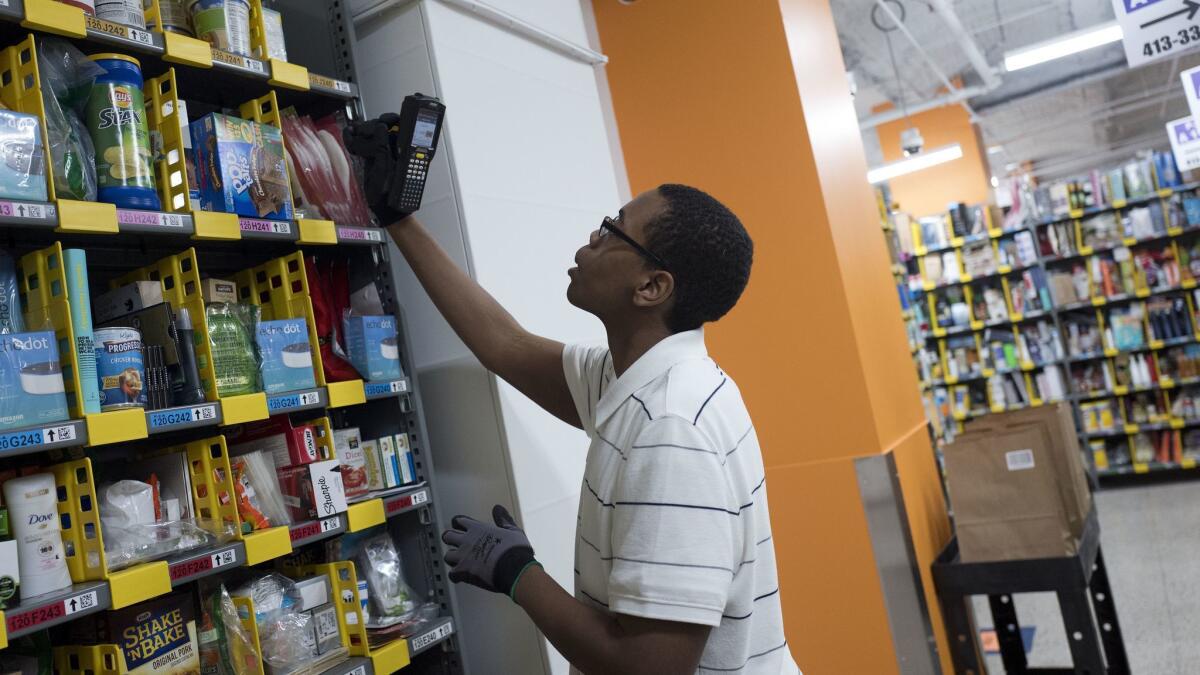Here’s why Amazon raised its minimum wage to $15 an hour

If, like me, you’ve been dying to hear some good news, then you surely welcomed Amazon’s decision to raise its minimum wage to $15 for all its 350,000 workers, including seasonal employees and temps, according to the company.
The decision is to some extent “bespoke,” in that Amazon is a uniquely large, hugely dominant firm capitalized at $1 trillion, run by one of the richest people in the world. But that too is fodder for analyzing why the company made this decision at this moment.
Tight labor market
Here’s how wage analyst Sylvia Allegretto, a labor economist at UC Berkeley, put it in the Washington Post: “We have a tight labor market, and these are tough jobs with high turnover rates. You add in that Amazon is competing for workers, and it makes sense that it is raising wages.”
Once the labor market hits full employment — an all too rare occurrence in recent decades — even employers of the magnitude of Amazon have to kick up pay to hire and keep the workers they need. Economists call demand for labor “derived” demand, as it is derived from the consumer demand for the goods and services workers produce. Such demand is strong right now, and companies either staff up to meet that demand or leave profits on the table.
There’s an important strain of work in economics these days that looks at the few firms — think Amazon, Google, Apple — that dominate their industry. Given that these firms have the market power to set prices and wages, why would Amazon raise its minimum? Even in a tight labor market, shouldn’t its size and clout preclude that move?
As Allegretto implies, maybe they could resist pay hikes at 5% unemployment but less so below 4%. I cannot underscore enough the importance of this insight. It means that if the Federal Reserve believes the lowest sustainable unemployment rate is 5% instead of 4%, literally millions of low-wage workers, disproportionately minorities and women, will never get a chance to reap the benefits of the expansion.
That said, given Amazon’s clout, it took more than low unemployment to enforce this change. It also took . . .
Political pressure
When Sen. Bernie Sanders (I-Vt.), scourge of the top tenth of the top 1%, and Bezos, denizen of that privileged niche, are exchanging loving tweets, attention must be paid. Sanders, along with Rep. Ro Khanna (D-Calif.), has long called out Amazon for its labor practices, and they recently introduced a bill, subtly entitled the Stop BEZOS Act. While I share their goal of pushing for higher pay for low-wage workers, I thought their bill, which charged companies for the public benefits its workers received, was misguided in that it would vilify legitimate benefit receipt and lead firms to discriminate against hires they thought might draw such benefits. But I have no question that their pressure was instrumental in driving this change.
Is there anything not to like?
Amazon should index its minimum wage for inflation, but we can argue about that later. The change is probably not as costly to the company as you might expect, as its fulfillment-center workers in higher-wage states already make around $15 an hour. But my research finds that Amazon has a lot of workers in Texas, Florida, Indiana and Kentucky, lower-wage states where the bump to $15 will constitute a real, much-welcomed raise.
It’s also the case that some of these higher labor costs will land right back in Amazon’s coffers. Think of this move as a bit like the service-sector version of Henry Ford, who recognized that unless he raised his workers’ pay, they couldn’t afford the cars they were making. I’m not saying $15 an hour is a living wage but it’s certainly a strong move in that direction.
Will this show up in higher inflation?
I doubt it. Wages and prices are slowly rising anyway, and while 350,000 is a lot of employees, there are 160 million workers in the labor force.
Finally, one last hand-clap for Amazon’s announcement, which included a decision to use its significant political heft to push for raising the federal minimum wage to $15 an hour. At one level, this can be seen as a play for its competitors to face the same wage floor Amazon just imposed on itself. But the statement also made a persuasive case for a higher federal floor:
“We will be working to gain congressional support for an increase in the federal minimum wage,” the company said. “The current rate of $7.25 was set nearly a decade ago. . . . We intend to advocate for a minimum-wage increase that will have a profound impact on the lives of tens of millions of people and families across this country.”
Jared Bernstein, a former chief economist for Vice President Joe Biden, is a senior fellow at the Center on Budget and Policy Priorities and author of “The Reconnection Agenda: Reuniting Growth and Prosperity.”






